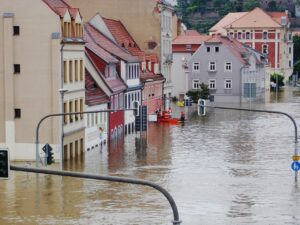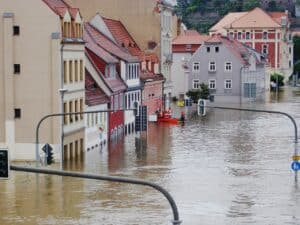Climate change is impacting our homes in many ways
 26 Agustus 2023
26 Agustus 2023
Climate change is impacting our lives in many ways. These include our homes. Whether someone is building, living in or trying to sell their home, they must be prepared for a variety of risks. Even people who live far away from high-risk areas will still feel impacts.
One increasingly frequent disaster triggered by climate change is flooding. Floods are also among the biggest natural risks to homeowners. They cause soil to dry out more quickly and absorb more water at once. According to researchers, these factors significantly increase flash flood frequency, making them faster and much larger.
People who live near bodies of water will experience similar situations, considering climate change melts glaciers and causes more severe rainstorms. Since a residential grinder pump can move wastewater uphill, it is the ideal tool for this scenario. It is more powerful than traditional lift pumps, making it best for the extreme situations climate change can cause.
Another side-effect of climate change is worsening air quality. Although climate change mainly lowers outdoor air quality, outside contaminants easily find their way inside. People living in these conditions will often feel sick and uncomfortable. Research shows those who consistently breathe poor-quality air have more respiratory infections like pneumonia.
To protect themselves, homeowners can install filters, keep their windows closed and use an air purifier. It is also smart to use a humidifier and regularly clean vents. While these are only temporary solutions, they keep people healthy.
Fluctuating housing prices
House prices can also fluctuate. Since mortgage providers require home insurance, homeowners without it cannot secure a mortgage. If they already have one, they will be in breach of contract if their insurance company pulls out of their state. Because of climate change, people could lose their homes on a technicality.
Even though the best option is to move somewhere less risky, many people do not have that choice. Alternatively, they can look for cost-saving measures to make it more affordable to live in their homes. The government has plenty of programs most people can easily qualify for.

For instance, the Biden Administration’s Inflation Reduction Act offers homeowners $1,200 annually if they install certain energy-efficient upgrades. It also provides various other tax credits, subsidies and loans.
Climate change is already impacting the real estate market. For example, waterfront homes are often much less valuable to potential buyers because the land is at risk for consistent flooding. Since severe climate change could even put coastal residential areas underwater, they have little reason to buy the property.
However, people who already own homes cannot do much to fix the real estate market, but they can try to take advantage when it turns in their favor. Those who have yet to buy property should avoid heavily forested, coastal or desert areas since climate change will affect them most.
Severe weather causes supply chain disruptions, which increase building material prices. As a result, new construction — even minor upgrades — becomes much more expensive for homeowners. People who plan on creating their dream home from the ground up should rethink their plans.
If traditional building materials are too expensive, they can always use alternatives. For example, they could build a trellis with live bamboo or use reclaimed bricks to make things more affordable. There are plenty of excellent options they can choose from.
Higher utility bills
Meanwhile, power outages can also become more frequent as the climate changes. The combination of higher utility use and severe weather increases the number of power outages homeowners will experience. Some cities may even require rolling blackouts to save energy costs. Essentially, citizens will pay more to use less electricity.
To be safe, people should get generators and solar panels to keep their homes running if the power grid goes down. Flashlights, candles, propane and natural refrigeration can help extend livability if blackouts go on for multiple days or fuel is scarce.
Utility bills are also set to increase. To combat rising temperatures, homeowners will need to run their air conditioning much more often. As a result, their energy bill will be much higher. Plus, power and water scarcity may drive costs up even more.
Installing living architecture is the best approach to offset high utility bills since greenery provides shade and absorbs heat. Homeowners can significantly lower their energy use with a green roof, lowering electricity costs.
White paint is another potential solution because it reflects and scatters sunlight. Surfaces coated in the world’s whitest paint significantly cooler day and night.
Damaged homes
At the same time, as climate change causes drastic temperature increases, triggering extreme weather events such as wildfires, these can severely damage homes. Even with quality insurance, people will have to fix their foundations and replace their roofs much more often.
Although homeowners cannot prevent these scenarios, they can prepare for them. Investing in more durable materials or waterproofing the basement could help protect their property from the worst damage.
These events can also make outdoor spaces unusable. Experts predict nearly 70% of people will live in severely hot, humid areas by 2050 because of climate change. Even if the global temperature only rises by a few degrees, they believe previously cool neighborhoods will face markedly higher temperatures.
Solar shading cools spaces year-round by blocking or reflecting sunlight, making it an ideal solution. Fixed versions are walls, roofs or overhangs built into a building, while the dynamic type includes canopies and special blinds.
As wildfires become much more common, they will place people’s landscaping at risk, considering trees and shrubs burn easily. Since embers and heat can travel hundreds of meters with the wind, experts recommend building a fire break to protect property.
A home should have a barrier — like a concrete sidewalk or a stone walkway — between itself and the lawn. Also, trees should have multiple feet of distance from each other to reduce the chance of the fire spreading. For homeowners who love greenery, experts recommend getting drought-resistant, high-moisture plants that can withstand high heat.
The post Climate change is impacting our homes in many ways appeared first on Sustainability Times.
